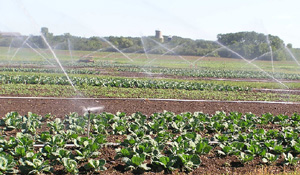Before Horizontal Air Flow (HAF) systems were developed, it was common to find 10°F to 15°F difference in nighttime temperature between the opposite ends of a greenhouse. Plant growth and quality often reflected this unevenness. Today with a properly installed HAF system, there should be no more than 2°F difference anywhere in the greenhouse.
Introduction to Greenhouse Efficiency and Energy Conservation
Contents
- Resources from eXtension Farm Energy
- Strategies and Checklists
- Construction and Comprehensive Greenhouse Guides
- High Tunnels
- Geothermal Heating
- Greenhouse Efficiency and Conservation Case Studies
- Miscellaneous Resources related to Greenhouse Energy
- Contributors to this Article
Greenhouses do their job most successfully using designs and siting for energy efficiency and maximum light transmission. Greenhouses must optimize crop growth and energy use by allowing sunlight in during the day, retaining as much heat as possible during cold weather, and providing sufficient ventilation to …
Gear Up and Throttle Back to Save Fuel
“Gear up and throttle back” is a fuel-saving practice suitable for light drawbar loads (less than 65% of full power) when reduced PTO speed is not a problem. For the most efficient operation, a tractor’s engine should be operated near its rated capacity. However, many field …
Geothermal Heat for Greenhouses
Soil and water below ground contain a vast reservoir of thermal energy. Geothermal heating systems recover this energy and convert it to heat that can be utilized in greenhouses and other buildings. Geothermal heat resources can be classified into three categories: low, medium, and high temperature.
Types of Geothermal Resources
- Low temperature (50°F +/-). The soil temperature at the surface varies considerably over the year and closely follows the air temperature. At the 5 to 6 foot depth, the
Optimizing Field Efficiency to Save Fuel
Introduction
Field efficiency means completing a particular field operation while wasting the least amount of time, fuel, and farm resources. The term refers to the time the operation should take vs. turning and other nonproductive time. For example, spending an inordinate amount of time turning around at the ends of short, wide fields or overlapping tillage operations within a field can result in higher fuel consumption per acre.
Machine maintenance and repair also affect field efficiency – equipment that is …
Natural Ventilation in High Tunnels
Roll-up sides and drop-down curtains are low-cost vent systems that can be installed in most high tunnels. These systems operate on the principle that heat is removed by a pressure difference created by wind gradients, so no energy is required to operate fans to move air. A wind speed of 2-3 miles per hour is adequate to force cool air in the windward sidewall. The air traveling over the high tunnel creates a vacuum on the leeward side to pull …
Energy Efficiency of Electric Motors on the Farm
The efficiency of a motor depends on how well it converts electrical power into work. Efficient electric motors have good starting and running performance, and provide a high level of reliability. An electric motor’s efficiency is numerically calculated as the ratio of the output power of the motor shaft over the electrical power required to turn the motor shaft and can be calculated using power values measured in wattage or horsepower.
Optimizing Electric Motor Efficiency
An electric motor’s rated efficiency …
Introduction to Energy Efficient Irrigation
|
|
|
Irrigation is Nevada. Photo: US EPA and National Archive and Record Administration; Wikimedia Commons. |
Learn how efficient irrigation technologies and practices reduce water and power costs.
Table Of Contents
Energy Efficient Irrigation
…Combat Higher Fuel Prices with Efficient Heating Systems
Heating fuel prices have been volatile over the past few years. How high they may go in the future will depend on many factors including the world fuel supply situation, demand, level of inflation and the weather. Good energy conservation measures can help to offset this increase and keep production costs under control.
Keeping the greenhouse heating system in peak operating condition is a good starting point. It can save by increasing efficiency, providing more uniform temperature in the growing …
High Tunnels – Low Cost Seasonal Growing Space
At a cost of $1 to $2 per square foot, a high tunnel can add low-cost growing space for season extension or plant protection. High tunnels also do not rely on as much energy inputs as traditional greenhouses with furnaces and forced-air ventilation. Growers and researchers are finding many innovative ways to utilize these structures to supplement their greenhouse operations.
By definition, the high tunnel is a walk-in, hoop or gothic-shaped pipe frame structure that is covered with a single …



